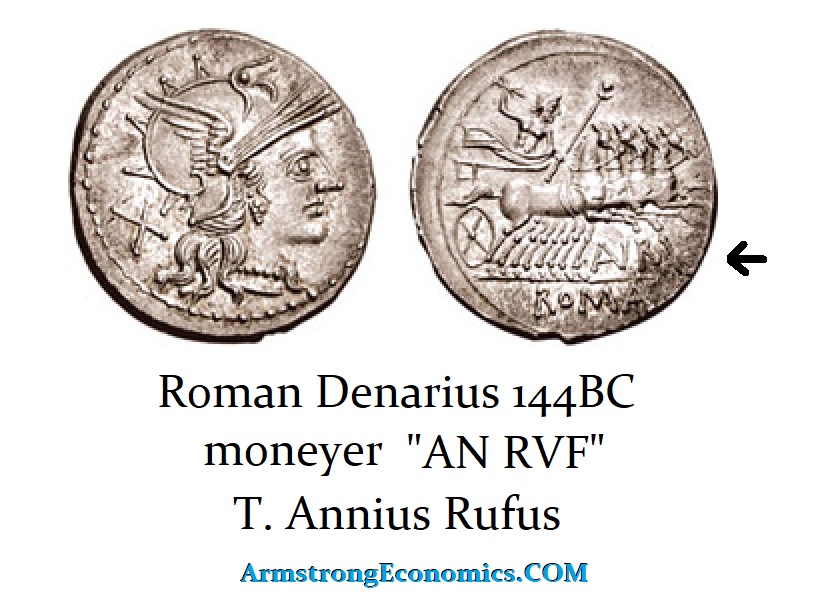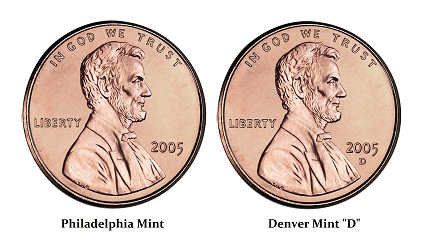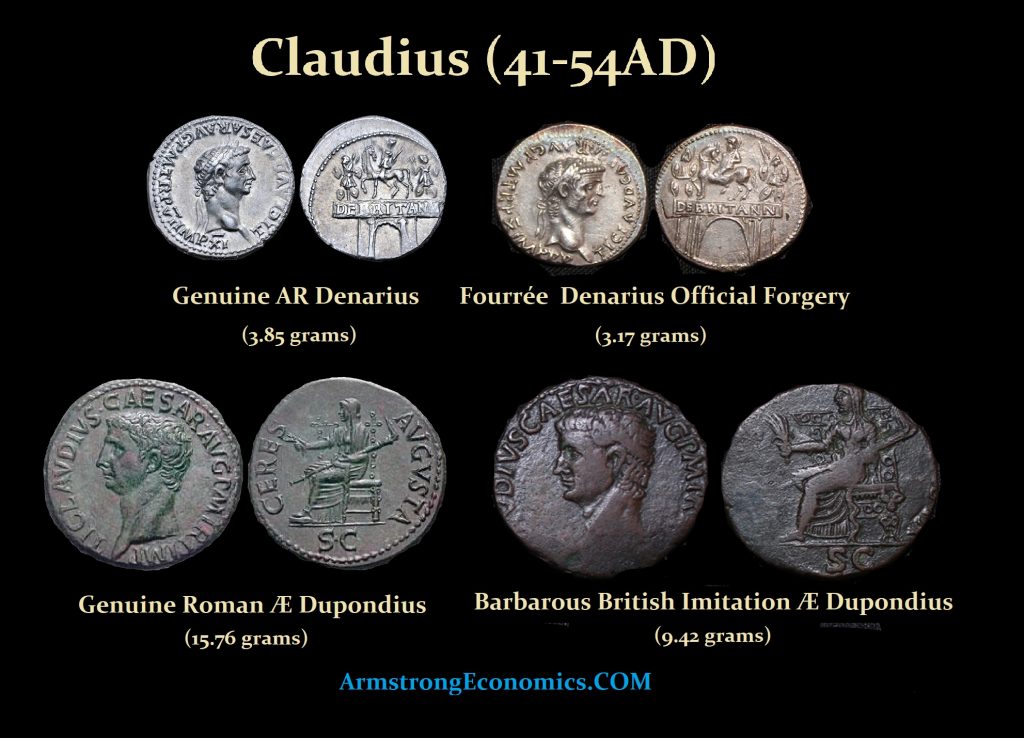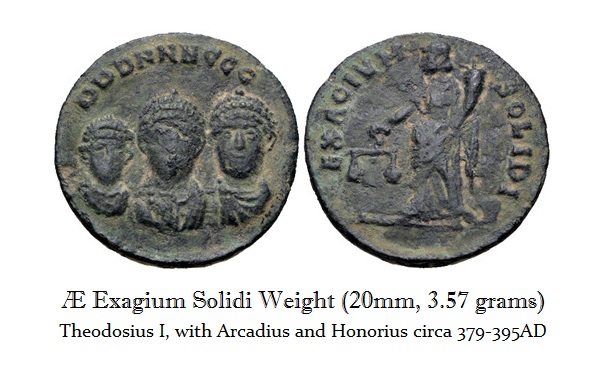Money Supply of Rome & Traditions
QUESTION: I found your article on the theory of money supply is not the source of inflation very fascinating. I was taken back by the fact that there were moneyers who signed the coins for their term each year as we still do today. Are there any other traditions from Rome that we still maintain with respect to money?
PF
ANSWER: That is an actually a good question for it demonstrates how traditions lose the purpose for what they were originally introduced as a solution. You will notice that some pennies or quarters, for example, have mint marks. There will be no mint mark reflecting it was coined in Philadelphia, “D” for Denver, and “S” for San Francisco. The Denver Mint was established to process the silver finds in Colorado and San Francisco was established because of the California Gold Rush. Those events are long since past but the mints still remain. Mints were also established in New Orleans (O) and Carson City Nevada (CC). They were closed after the roaring bullion days.
There were forgeries of coins in the precious metals as well as bronze just about as soon as coins were invented. When you look at the counterfeits that were being made in the outer regions surrounding the Roman Empire, we can easily distinguish such forgeries based upon style looking at the bronze Dupondius of Claudius (41-54AD). The forgers obviously lacked people with talent to copy the dies. Now, look at the silver denarius forgery. Here the style is professional. Such forgeries are made from bronze and silver plated. They are called Fourrée Denarii being plated in silver. The dies are professional. Because these are known throughout the entire run of Roman coins, it is believed that this high level of quality was probably “officially” produced in the various mints. It is most likely that they were frauds by the mint staff rather than officially sanctioned.
When Government No Longer Accepts Its Own Money
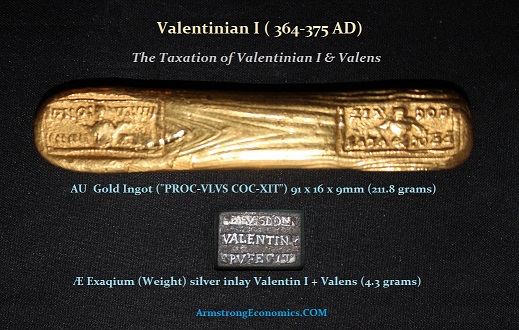
Despite the fact that the Emperor Valentinian I (364-375 AD) faced constant frontier wars, he addressed the finances of the Empire head-on. In 366 AD, Valentinian carried out an important reform of the tax-collection system which was enacted whereby payments to the Imperial Treasury would no longer be made in coin but in refined bullion. All coins were to be melted down and refined being poured in the form of officially certified gold and silver bars as pictured here. Taxes were to be paid in bullion and not coin to ensure the highest metal content. Effectively, the government would no longer accept its own coinage as legal tender. The existing coinage was melted down as a necessity because of the quality of the metal content and the underweight of the coinage in addition to the pervasive counterfeit coinage in circulation, undermined the confidence in the circulating currency.
Additionally, some mints were engaged in outright fraud as mentioned above. Mint staff had become very corrupt by this point in time during the 4th century and the problem was so acute that the anonymous author of the “De Rebus Bellicis”, which was a work that suggested remedies for the military and financial problems in the Roman Empire at that junction in history, recommended action against the mint staff. This work recommended isolating all the monetary staff producing coinage and prosecuting them for their frauds. The new system of melting down the coinage introduced by Valentinian I ensured that the treasury was refilled with the added advantage of restoring both the public and foreign confidence in the precious metal coinage once again. New arrangements were also put in place for the making of gold and silver denominations under the control of the Emperor. Previously, this had been in the hands of the various mintmasters. Valentinian’s reform was aimed at limiting the activities of the mint staff to the production of base metal coinage while gold and silver denominations were to become the prerogatives of potentially mobile minting establishments operating in the environments of the Imperial palaces where ever the Emperor happened to be in residence.

Rome during the 3rd century introduced mint marks to keep track of what coins were produced from what mint. In this way, they were able to identify any mint that was cheating the people. Aurelian (270275AD) returned to Rome in 271 AD, where he had to pacify a terrified city. He immediately halted the rioting and restored order to the capital. The controller of the mint in Rome began a rebellion over the monetary reforms laid out by Aurelian. He ordered that all the debased currency be purchased back and replaced with a new currency of higher content in silver. The rebellion was led by Felicissimus. It appears that those who had been running the mint were embezzling the intended silver and issuing the debased coinage at least in part on their own authority. Obviously, any reform to the monetary system that called for an increase in silver content would have been unprofitable for those running the mint for personal gain. In the rebellion, as many as 7,000 soldiers died when Aurelian was forced to trap and execute them and their allies, some of the senatorial rank, in a terrible battle on the Caelian Hills. Now that is what you call monetary reform!
Currently, the advantage of paper money is that there are far fewer counterfeits in circulation today compared to Rome during the 4th century AD. The emperor who followed Valentinian I was still facing problems with the currency. Here is an Æ Exagium which is a Solidi Weight (20mm, 3.57 grams) for testing gold coins issued under Theodosius I. Clearly, the idea of a gold standard was not all that it was cracked up to be. Counterfeits were always a problem in addition to clipping and shaving the coinage to lighten the weight.
They often say the more things change, the more they remain the same. Some artists who were proud of their work signed the dies for coins. We find the artist who created the Lincoln penny signed the die in 1909 engraving his initials V.D.B. as did the artist Kimon in ancient Sicily on the Decadrachms of Syracuse during the 4th/5th century BC engraving his initials “KI” on the headband.
